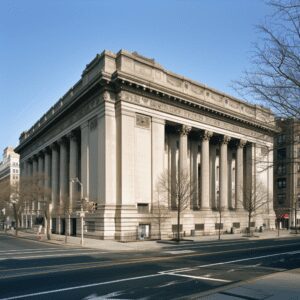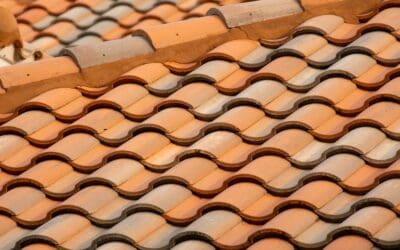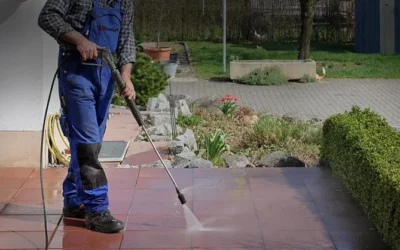Preserving History: Pressure Washing Tips for Historic Buildings

Regarding pressure washing, not all buildings are created equal, not all materials can withstand the same pressure, and not all cleaning solutions are safe for every surface. You’re facing a unique challenge when you’re tasked with pressure washing a historic building.
There’s more at stake than removing years or centuries of accumulated grime. It would be best to balance the need for a thorough cleaning with the imperative to preserve the building’s historic integrity. Every brick, every beam, every architectural detail carries a piece of history that deserves your careful consideration and respect. As you prepare to undertake this task, you may wonder: what should you be aware of, and how should you proceed? Let’s unpack the special considerations for pressure washing historic buildings and discover how to ensure that history stands the test of time – and pressure washing.
Understanding Historic Building Materials

Delving into historic building materials, you must recognize the differences between siliceous and calcareous natural stone materials for effective cleaning and preservation. Siliceous stones, like granite or slate, are durable and resist damage, but beware of the risks of abrasive cleaning. It can scratch and dull the surface, diminishing the stone’s natural beauty. On the other hand, calcareous rocks, such as limestone or marble, are more porous and sensitive to acidic cleaners, which can etch or discolor them.
Understanding the impact of finishes on cleaning outcomes is equally important. The finish of a stone, whether polished, honed, or natural, can significantly influence its interaction with cleaning agents. A polished surface, for instance, is more prone to show etching and requires gentler cleaning methods.
And don’t forget about adjacent materials. The cleaning process should not compromise them, so always consider them when planning your cleaning strategy.
Be sure to consider environmental impact and weather conditions, too. They can affect the cleaning process and the preservation of the materials. With nuanced understanding and careful planning, you can maintain the integrity of historic buildings while effectively removing grime and pollutants.
Risks of Pressure Washing Historic Buildings
While pressure washing can undoubtedly result in a brilliantly clean exterior, it’s essential to be aware of the potential risks, as high-pressure water can erode surfaces over time, leading to discoloration and structural damage. This is particularly true when dealing with historic buildings, where materials may be more fragile and susceptible to potential damage.
One of the common mistakes is using a pressure setting too high for the surface being cleaned. This can cause irreversible harm to delicate materials such as wood, masonry, or intricate architectural details. Moreover, pressure washing can indirectly damage these materials by propelling debris towards them at high velocities.
A further risk involves the peeling of paint and denting of surfaces, compromising not just the aesthetic appeal but also the structural integrity of the building. Therefore, engaging a professional with experience in pressure washing historic buildings is crucial. They’ll understand how to adjust the pressure and select the right cleaning agents to avoid these pitfalls.
In short, while pressure washing can achieve a pristine exterior, it must be cautiously undertaken to prevent costly and potentially irreparable damage to your historic building.
Safe Cleaning Techniques
To ensure the preservation and longevity of your historic building, it’s critical to employ safe cleaning techniques during pressure washing. One of the foremost considerations is identifying fragile artifacts such as delicate woodwork, fragile masonry, or intricate architectural details. These elements require special attention and a different cleaning approach to avoid causing irreversible damage.
Understanding the environmental impact is also crucial. An environmental impact assessment can help determine the best cleaning solutions to use that are both effective and environmentally friendly.
Here are four key points to remember:
- Always use low pressure, less than 500 PSI, and wide water spray tips.
- Choose non-abrasive and environmentally friendly cleaning solutions.
- Engage a professional with experience in pressure washing historic buildings.
- Collaborate with architectural conservators to determine the optimal PSI and avoid unnecessary damage.
Importance of Low-Pressure Washing
Building upon safe cleaning techniques, understanding the importance of low-pressure washing becomes paramount, especially when dealing with delicate historical surfaces. Unlike high-pressure methods, low-pressure washing gently removes dirt and grime without eroding the integrity of the surface material. This is particularly crucial for historic buildings which often feature intricate decorations and porous materials that can be easily damaged by high-pressure washing.
Low and high-pressure debate comes down to the impact on paint and finishes. High pressure can strip paint, scratch surfaces, and degrade finishes, stripping your building of its unique qualities and historical authenticity. In contrast, low-pressure washing allows for a thorough cleaning that preserves the paint and finishes, maintaining the original look and feel of the building.
Working with professionals experienced in low-pressure washing methods is essential. They understand the delicacy of historical materials and the intricacies of preserving them. A professional approach ensures that the unique qualities of your building are maintained, contributing to the preservation of our shared cultural heritage. So, when it comes to cleaning historic buildings, remember, low-pressure washing isn’t just important; it’s paramount.
Choosing the Right Cleaning Agents
Choosing the right cleaning agents is a critical step in pressure washing historic buildings, as these agents must effectively remove dirt while preserving the integrity of the unique, often delicate materials. The wrong choice could inadvertently damage irreplaceable architectural details, so selecting products wisely is crucial.
Here are a few key points to consider:
- Opt for gentle, non-abrasive cleaners that remove organic dirt like mold or mildew without harming the buildings’ unique materials.
- Know the original materials used in the building. This knowledge will guide you in choosing the right cleaning solutions.
- Consider specialized cleaning agents designed for historic surfaces. Options like water-based, chemical, abrasive, laser, and dry ice cleaners can be beneficial.
- Engage professionals experienced in cleaning historic buildings. They’ll use safe cleaning techniques and understand the benefits of regular cleaning for preservation.
Identifying Fragile Architectural Details
When pressure washing, accurately identifying the fragile architectural details of your historic building is a crucial step to prevent potential damage. This isn’t a task to be taken lightly, as ornate carvings, intricate moldings, and fragile stonework can easily suffer irreparable harm if not properly recognized and protected.
To ensure the safety of these unique features, you might consider consulting conservators. These professionals have the necessary expertise to thoroughly assess your building’s historic features and materials and can guide you in identifying those more susceptible to damage.
A conservator’s input can be invaluable in mapping out a safe and effective pressure-washing plan. Their knowledge of delicate architectural elements will allow them to identify areas that require a gentler touch or should be avoided during cleaning.
Special Care for Wood and Masonry
How should you approach delicate wood and masonry pressure washing in historic buildings? First, it’s paramount to identify restoration needs. This involves evaluating the building’s condition, considering the effects of weathering on wood and masonry, and understanding the building’s historical significance.
It would be best if you considered the following:
- Low-pressure methods and gentle cleaning solutions prevent damage to the wood or masonry.
- Avoid abrasive cleaning techniques that could harm the building’s unique characteristics.
- Selecting appropriate pressure washing tips and techniques to avoid stripping paint or scratching surfaces.
- Collaborating with architectural conservators to determine optimal pressure levels for cleaning.
Addressing weathering effects requires a detailed understanding of the building materials and their reaction to various cleaning techniques. Preserving the building’s unique characteristics is crucial, so using non-abrasive and environmentally friendly cleaning solutions is highly recommended.
Hiring a Professional Washer

After taking the necessary precautions to preserve the unique characteristics of your building’s wood and masonry, it’s crucial to enlist the expertise of a professional washer familiar with handling historic properties. These professionals possess the knowledge, appropriate tools, and equipment to protect delicate features while effectively removing dirt and grime.
Hiring professionals is a cost-effective solution in the long run. Initially, it may seem like an additional expense. However, consider the potential cost of repairs if an inexperienced person inadvertently damages a historic detail. Professionals also minimize disruption to the surrounding area and can efficiently clean your property, saving you time and effort.
Professionals are well-versed in using gentle cleaning agents and disposing of them correctly, thereby reducing the environmental impact. This level of expertise ensures the preservation and maintenance of your building, retaining its cultural and historical value.
Benefits of Regular Cleaning

Regular cleaning through pressure washing enhances the aesthetic appeal of your historic property and plays a crucial role in maintaining its structural integrity. The benefits of regular cleaning are manifold and, when done right, can yield significant results for preserving architectural details.
Here are some key benefits to appreciate:
- Pressure washing removes organic dirt like mold and mildew, which can cause decay and degradation if left untreated. This not only boosts the property’s appearance but also its healthiness.
- Regular pressure washing helps maintain the structural integrity of the building. By removing harmful substances, you’re actively preventing long-term damage and costly repairs.
- It’s cost-effective. Pressure washing offers a practical and affordable choice for regular maintenance compared to other cleaning methods.
- Another advantage is its versatility. It can be used on various surfaces and is adaptable to different areas of the property.
Avoiding Common Mistake
When pressure washing your historic building, it’s essential to sidestep common pitfalls that could damage its delicate fabric or disrupt the surrounding environment. Many mistakes stem from common misconceptions about the process. For instance, the belief that high pressure is required for effective cleaning can lead to irreparable harm to the building’s intricate architectural details.
To mitigate potential risks, you should always work with experts in historic preservation. They understand the delicate balance between cleaning and conservation and, thus, can guide you on the appropriate pressure levels and cleaning agents to use.
It’s also crucial to consider the environmental implications of pressure washing. If not properly managed, the runoff could impact local flora and fauna. Ensure you use eco-friendly cleaning solutions and dispose of them responsibly after use.
Monitoring for Potential Damages
Pressure washing historic buildings demands vigilant monitoring to identify and prevent potential damages. It would be best to remain watchful for early signs of harm to the structure. This isn’t just about preserving beauty but also about maintaining the integrity of the building.
Monitoring for potential damages involves a few key steps:
- Carefully observe the building surface before, during, and after cleaning.
- Checking for any changes in the building materials’ color, texture, or condition.
- Paying attention to particularly vulnerable areas, such as ornate details or aged wood.
- Documenting any damages, ideally with photographs, to aid in potential restoration efforts.
While you’re looking for damages, you’re also assessing cleaning effectiveness. Is the grime and dirt being removed? Are there areas that need more attention? By monitoring the process, you can ensure the cleaning is effective and safe for the structure.
Maintenance Plans for Preservation
Crafting a comprehensive maintenance plan for your historic building is essential in preserving its character and ensuring its longevity. Understanding maintenance processes is crucial in this endeavor. It involves meticulous planning, prioritization of tasks, and effective record-keeping.
Here are some critical steps to consider:
- Seek professional help to establish an initial plan. This should include schedules, checklists, and forms for thorough inspections and systematic record-keeping.
- Prioritize maintenance tasks based on the building’s vulnerability and its defining elements. This will help protect the most critical parts of your property.
- Conduct regular maintenance inspections. A cyclic building inspection checklist will guide this process and ensure no area is overlooked.
- Maintain up-to-date records of all maintenance activities. This aids in future planning and allows tracking of changes and issues over time.
Importance of Aftercare and Maintenance
Once you’ve navigated the legalities and completed the pressure washing process, you must not overlook the importance of aftercare and maintenance for your historic property. Regular inspections and professional maintenance are instrumental in preserving your building’s integrity and extending its lifespan.
The importance of regular inspections can’t be overstated. They help identify potential issues early, allowing timely intervention and preventing extensive damage. You’re essentially slowing down the natural deterioration process and minimizing the impact of natural occurrences.
Professional maintenance brings numerous benefits. Having experts who understand the unique materials and architectural details of your building can help you avoid treatments that may cause long-term damage. They can guide you in creating a comprehensive maintenance plan that:
- Preserves historic materials over time
- Eliminates redundancy and prioritizes tasks
- Includes routine care for roofs, exterior walls, windows, and doors
- Addresses landscaping and drainage issues
In short, aftercare and maintenance are just as crucial as the cleaning process itself. By giving these tasks the attention they deserve, you maintain your building’s aesthetic appeal and safeguard its historical significance for future generations.
Hiring Bradenton Pressure Washing: The Expert Choice for Your Historic Building
When it comes to maintaining the integrity and beauty of your historic building, choosing your pressure washing professional is crucial. This is where Bradenton Pressure Washing emerges as your ideal partner, blending the art of gentle cleaning with the science of preservation.

Why Bradenton Pressure Washing is the Perfect Fit
Bradenton Pressure Washing has carved a niche in handling historic properties with the utmost care and professionalism. Here’s why we stand out:
Experience with Historic Buildings: Understanding the unique challenges posed by historic structures, Bradenton Pressure Washing employs techniques specifically tailored to protect and preserve these treasures.
Gentle Yet Effective Cleaning: Using low-pressure methods combined with gentle, environmentally friendly cleaning solutions, ensure your building’s historical charm is maintained while effectively removing dirt and pollutants.
Expertise in Handling Delicate Surfaces: The team is well-versed in dealing with various historic materials, from fragile woodwork to porous masonry, ensuring that every surface is treated with the respect it deserves.
Customized Cleaning Approach: Recognizing that no two historic buildings are the same, Bradenton Pressure Washing offers customized cleaning plans, thoughtfully designed to meet the specific needs of each property.
Commitment to Preservation: The goal is to clean and preserve. Bradenton Pressure Washing collaborates with architectural conservators to ensure their methods align with the best practices for historic preservation.
Proven Track Record: With numerous satisfied clients in the realm of historic building maintenance, it speaks volumes of the ability to handle your property with the care it requires
Contact Bradenton Pressure Washing today and take the first step towards preserving your historic building’s grandeur and legacy.



